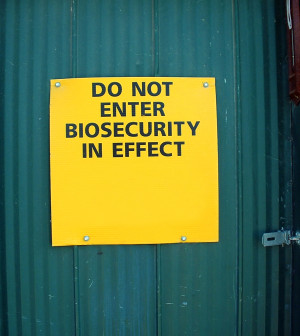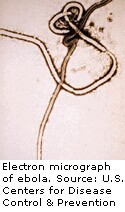- Skip Storing This Everyday Product in the Fridge Door
- Green Tea + B3 Pairing May Boost Brain Health
- Navigating Your Midlife Crisis: Embracing New Possibilities
- City Raccoons Showing Signs of Domestication
- Mapping the Exposome: Science Broadens Focus to Environmental Disease Triggers
- One Week Less on Social Media Linked to Better Mental Health
- Your Brain Changes in Stages as You Age, Study Finds
- Some Suicide Victims Show No Typical Warning Signs, Study Finds
- ByHeart Formula Faces Lawsuits After Babies Sickened With Botulism
- Switch to Vegan Diet Could Cut Your Greenhouse Gas Emissions in Half
2nd American Ebola Patient Arrives in U.S. for Treatment


The second of two Americans stricken with Ebola in the West African nation of Liberia arrived in the United States on Tuesday for treatment, according to media reports.
Carried in a plane specially outfitted with an isolation unit, Nancy Writebol, 59, arrived just outside Atlanta Tuesday morning, NBC News reported. She was taken to Emory University Hospital where she was wheeled in on a stretcher. Another American patient with Ebola, Dr. Kent Brantly, 33, is already receiving care at the facility.
Brantly was delivered Saturday morning to Emory in the same plane and is showing signs of improvement, experts said.
Media reports published Monday said that both Brantly and Writebol received an experimental drug while in Liberia that appears to have helped them recover from Ebola, which has a high fatality rate.
Brantly “seems to be improved from the reports we got earlier,” Dr. Tom Frieden, director of the U.S. Centers for Disease Control and Prevention, said Sunday on NBC’s “Meet the Press.”
An unnamed source told CNN that the U.S. National Institutes of Health contacted Samaritan’s Purse, the aid agency Brantly works for, and offered three vials of an experimental treatment called ZMapp for use in both patients.
According to the CNN source, ZMapp is a drug being developed by San Diego-based biotech company Mapp Biopharmaceutical. Although the medicine has shown promise in trials involving monkeys, it has never been tested in humans. In the primate trials, four monkeys infected with Ebola survived after getting Zmapp within 24 hours of infection, and two of four other monkeys survived after getting the serum within 48 hours of infection.
CNN said that Brantly woke up July 22 feeling feverish and immediately put himself into isolation. Writebol came down with similar symptoms three days later, and blood tests confirmed that both Americans had contracted Ebola.
ZMapp must be kept frozen. Upon its arrival at the Liberian hospital where Brantly and Writebol were being treated, the serum was allowed to thaw naturally, a process taking 8 to 10 hours, CNN said.
According to a CNN source, Brantly asked that Writebol be given the first dose of ZMapp because he was younger than Writebol and more likely to survive. She agreed but once Brantly’s condition deteriorated — he had difficulty breathing and believed he was dying — the decision was made to give him the first, thawed dose.
The treatment seems to have worked. Just one hour after receiving intravenous delivery of ZMapp, Brantly made a dramatic recovery, CNN reported. He began breathing on his own and a rash that had once covered his trunk faded away. By the next morning, Brantly could take a shower on his own before his evacuation to the United States.
Writebol also received ZMapp. Her response after the first dose was not as dramatic as that seen in Brantly, but a second dose was given on Sunday and Writebol has made a significant recovery, CNN said.
How did the two American patients get access to a drug whose safety and effectiveness hadn’t yet been tested in humans? Experts noted that the U.S. Food and Drug Administration will allow such access in emergency situations based on “compassionate use,” although the speed at which the treatment made it to the two patients is remarkable.
After being flown from Liberia on the specially outfitted plane, Brantly climbed out of an ambulance on Saturday with the aid of another person and then walked the short distance to the entrance of Emory University Hospital. Both Brantly and the person who helped him were wearing special biocontainment suits and similar protective gear, NBC News reported.
Experts said the fact that Brantly could walk on his own was an encouraging sign.
Both Brantly and Writebol had been working at clinics in Liberia, helping victims of an Ebola outbreak that the World Health Organization says has already killed at least 887 people. Brantly is with the aid agency Samaritan’s Purse.
The unit at Emory where Brantly and Writebol will be cared for has been designed for just these types of cases. In a statement, Emory said that the unit “has unique equipment and infrastructure that provide an extraordinarily high level of clinical isolation.” Staff who work in the unit are specifically trained and practiced in treating “this type of patient,” the hospital said.
There’s no cure or vaccine for Ebola, which wreaks life-threatening havoc on the body by attacking multiple organ systems simultaneously.
Meanwhile, Fox News reported Monday that a patient is being tested for the Ebola virus at Mount Sinai Hospital in New York City. The patient had recently returned from a West African country hit by the Ebola outbreak, the hospital said Monday afternoon.
After arriving in the emergency room Monday morning with a high fever and gastrointestinal symptoms, the man has been quarantined while medical tests are done, Fox News reported.
“All necessary steps are being taken to ensure the safety of all patients, visitors and staff,” the hospital said in a statement, Fox News reported.
Officials from the U.S. Centers for Disease Control and Prevention told Fox News there have been “a half dozen or so” similar patients in the United States who have been tested for possible Ebola infection, and that all tests have turned out to be negative.
More information
For more on the Ebola virus, visit the
U.S. Centers for Disease Control and Prevention.
Source: HealthDay
Copyright © 2025 HealthDay. All rights reserved.










